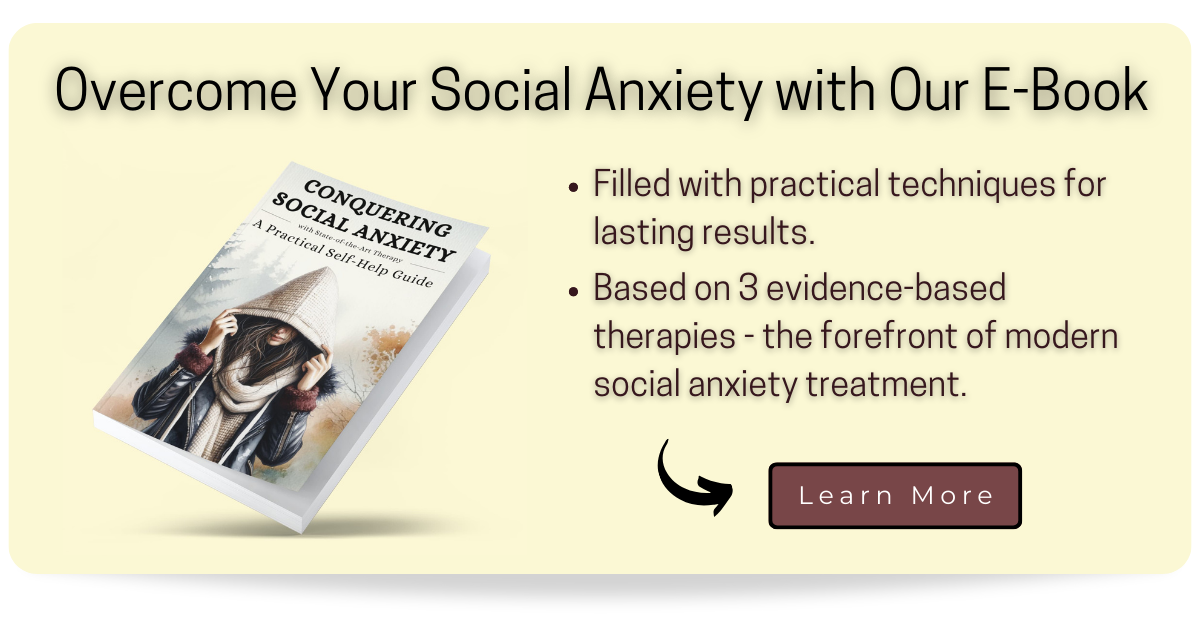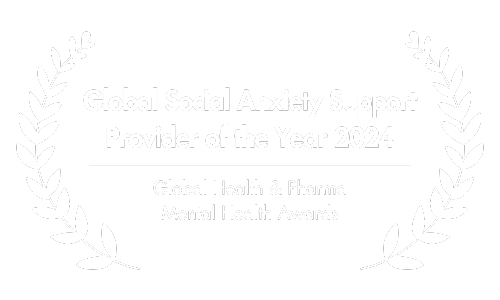Tackling Social Anxiety Head-On: A Guide to Shame Attacking Exercises
This article includes recommendations for two books & an online therapy service that help with social anxiety. Some of our links may grant you a significant discount and we will earn a commission.
For many people, shame is a fleeting emotion, a momentary discomfort that follows a minor social blunder.
But for those grappling with social anxiety disorder, shame takes on a far more significant and debilitating role.

In this article, we delve into the transformative potential of shame attacking exercises—a strategy that may seem daunting but is remarkably effective in alleviating the symptoms of social phobia.
Please note: If you’re struggling with social anxiety, it’s crucial to consult with healthcare professionals for a diagnosis and treatment plan tailored to your individual needs.

A. The Amplified Role of Shame in Social Anxiety
While shame is a universal emotion, its impact is particularly magnified for individuals dealing with social anxiety.
For the average person, shame might be a temporary feeling that fades away after a social misstep.
However, for those wrestling with social anxiety disorder, shame becomes a constant companion, lurking in the background of every social interaction.
This heightened sensitivity to shame often leads to what psychologists term ‘experiential avoidance‘, which has been linked to social anxiety and other psychological struggles (Chawla & Ostafin, 2007).
In essence, individuals with social phobia go to great lengths to avoid situations that could trigger feelings of shame or embarrassment.
This avoidance might offer temporary relief but ultimately serves to reinforce the cycle of anxiety and shame, trapping the individual in a self-perpetuating loop of emotional distress.

B. The Psychology Behind Shame and Social Anxiety
Understanding the psychology of shame and social anxiety is crucial for grasping why shame attacking exercises can be so transformative.
Two key psychological principles come into play here: habituation and extinction learning.
Habituation refers to the process where your brain becomes accustomed to a recurring stimulus—in this case, the emotion of shame.
Over time, as you repeatedly expose yourself to situations that trigger shame, your emotional response begins to wane.
Your brain learns to see these situations as less threatening, reducing the intensity of your emotional reactions.

Extinction learning takes this a step further. It’s the psychological mechanism that allows your brain to ‘unlearn’ a previously acquired fear.
When you consistently face situations that induce shame but result in no catastrophic outcomes, your brain starts to adapt.
It learns that the feelings of shame and embarrassment do not lead to the dire consequences you once imagined.
Together, these principles form the backbone of traditional exposure therapy, a well-established treatment for various anxiety disorders, including social phobia.
By applying these principles through shame attacking exercises, you can disrupt the self-perpetuating cycle of shame and experiential avoidance, paving the way for a more fulfilling social life.

C. The Evolution of Shame Attacking Exercises
The concept of shame attacking exercises isn’t new; it has evolved over time and across various psychological frameworks.
Albert Ellis, a pioneer in the field of cognitive behavioral therapy, was among the first to introduce this radical approach.
He argued that by deliberately placing oneself in embarrassing situations, individuals could confront and disarm their dysfunctional feelings of shame.
Over the years, this concept has been adapted and renamed, appearing under various guises such as “comfort zone challenges” and “social mishap exposures“.

Despite the different terminologies, the core principle remains consistent: intentionally seeking out shame-inducing situations can significantly reduce both the frequency and intensity of shame experienced in social settings.
This approach has gained empirical support in recent years, with studies showing its effectiveness in treating social anxiety disorder.
By embracing the discomfort associated with shame, individuals can break free from the self-imposed limitations that social anxiety often brings.

D. How to Implement Shame Attacking Exercises
Taking the plunge into shame attacking exercises can be intimidating, especially for those dealing with social anxiety.
However, the process can be broken down into manageable steps to make it less daunting.
- Identify Trigger Situations: The first step is to identify social situations that typically induce feelings of shame or embarrassment. These could range from speaking up in a meeting to making eye contact with strangers.
- Plan Your Exercise: Once you’ve identified your triggers, plan an exercise that deliberately exposes you to that situation. For example, if making eye contact is difficult for you, your exercise could involve maintaining eye contact with strangers as you walk down the street.
- Duration Matters: It’s crucial to stay in the situation long enough for your initial emotional response to subside. This usually happens after about 60 to 90 seconds. The goal is to allow your brain the time it needs to adapt and reframe the experience as non-threatening.
- Repeat for Effect: One-off exercises are unlikely to bring about lasting change. For the most impact, these exercises should be repeated multiple times, allowing your brain to fully adapt and ‘unlearn’ the associated fear.
- Reflect and Adjust: After each exercise, take some time to reflect on the experience. Did your feelings of shame subside? Were the outcomes as catastrophic as you had feared? Use these reflections to adjust your approach for future exercises.

By following these steps, you’re not just confronting your fear of shame; you’re actively rewiring your brain to respond differently to it.
This can be a powerful catalyst for reducing the symptoms of social anxiety and improving your overall quality of life.

E. Big Challenge, Big Reward
Embarking on a journey to confront your deepest fears and insecurities is no small feat, especially for those struggling with social anxiety.
The very idea of intentionally seeking out shame-inducing situations can seem counterintuitive, if not downright terrifying.

However, the rewards for taking on this challenge can be life-changing.
This approach has been empirically validated as highly effective in treating social anxiety disorder, as evidenced by multiple studies (Clark et al., 2003; Hofmann & Otto, 2008; Hofmann & Scepkowski, 2006).
By facing the situations you’ve spent so much time avoiding, you’ll likely find that the consequences are neither as severe nor as irreversible as you had imagined.
Moreover, the act of repeatedly confronting your fears can lead to a profound shift in your mindset.
Over time, you’ll begin to see these exercises not as threats, but as opportunities for growth and personal development.
This shift can significantly reduce the hold that social phobia has over your life, allowing you to engage more freely and confidently in social situations.

F. Sample Exercises to Get You Started
If you’re ready to take the first step but aren’t sure where to begin, here are some sample shame attacking exercises to kickstart your journey.
Remember, the goal is not to humiliate yourself but to confront and become more comfortable with feelings of shame and embarrassment.
In a research study published in 2013, Fang et al. proposed various exercises, such as walking backwards in a crowded area for three minutes or asking three subway passengers if they could spare $20, to challenge social norms and induce feelings of shame.

Here are some additional ideas:
- Drop Change at a Crosswalk: Let a handful of coins fall and take your time picking them up, even if it means holding up traffic momentarily.
- Ask for a Taste: Approach strangers eating ice cream and ask if you can have a taste.
- Sing Publicly: Choose a busy street corner and sing your favorite song out loud.
- Pretend to be an Influencer: Walk around a public area while filming yourself talking about your day as if you’re a famous influencer.
- Compliment Strangers: Approach people you find attractive and give them a genuine compliment.
- Recite Poetry: Stand on a subway platform and recite a poem loudly enough for everyone to hear.
- Public Dance: Put on some music and dance in a public square.
- Attempt to Buy an Embarrassing Item: Go to a store, pick up an item you find embarrassing, and then tell the cashier you don’t have enough money to buy it.
- Public Push-Ups: Drop down and do five push-ups in the middle of a crowded area.
- Call Out for a Friend: Enter a store and loudly call out a friend’s name as if you’re trying to find them.

Feel free to adapt these exercises to fit your comfort level or come up with your own.
The key is to choose situations that will induce feelings of shame or embarrassment and to stay in them long enough for your emotional response to subside.
G. Recommendations for Further Support
While shame attacking exercises are a powerful tool for combating social anxiety, they are most effective when used in conjunction with other resources and treatments.
Here are some recommendations to provide a more comprehensive approach to managing your social anxiety:
Book Recommendation
Brené Brown’s “The Gifts of Imperfection” delves into the complexities of shame and vulnerability. Brown’s research-based insights can offer you a deeper understanding of your emotional experiences and guide you towards embracing your imperfections. You can order it here.
Workbook Recommendation
“The Shyness and Social Anxiety Workbook” offers practical exercises and strategies to manage social anxiety. This workbook can serve as a valuable supplement to your shame attacking exercises, providing a structured approach to tackling social anxiety. It is available for purchase here.

Online Therapy Recommendation
Our partners from Online-Therapy offer a tailored experience, including 1 live session per week (video, voice, or text), unlimited messaging, an 8-section CBT program with 25 worksheets, daily worksheet replies, yoga, meditation videos, a journal, activity plan, and self-assessment tests.
You can even switch therapists easily for the right fit, all while ensuring a secure and confidential therapeutic environment.
When registering, make sure to choose ‘individual therapy‘ and then select ‘social anxiety‘. After that, you can provide further details about your particular situation.
Their plans start at just $40 per week. You can use the following link to sign up, which will grant you a 20% discount for your first month of therapy.

H. Conclusion
Shame attacking exercises offer a counterintuitive yet profoundly effective approach to tackling social anxiety.
By deliberately seeking out situations that induce shame and staying in them long enough for the emotional response to subside, you can rewire your brain’s reaction to these triggering events.

This can be a transformative experience, breaking the cycle of experiential avoidance and reducing the symptoms of social phobia.
While the journey may be challenging, the rewards are well worth the effort.
Coupled with additional resources like books, workbooks, and online therapy, shame attacking exercises can serve as a powerful tool in your mental health toolkit.
So, if you’re ready to take control of your social anxiety and live a more fulfilling life, the first step is yours to take.

Also, if you’re eager to embark on a journey of exploration through diverse therapeutic avenues to address social anxiety, we invite you to discover our comprehensive therapy guide by clicking right here.
Furthermore, if you’re seeking a comprehensive overview that spans therapy, medication, and self-help approaches, you’re welcome to dive into our in-depth guide available here.
In addition, we have created a comprehensive guide to pharmacotherapy for social phobia. If you are interested in medication approaches, just click here.
Still have lingering questions? Take a step toward clarity and empowerment by enrolling in our Free 7-day Email Course. We’re dedicated to being your guide on this journey of understanding and growth.

Chawla, N., & Ostafin, B. (2007). Experiential avoidance as a functional dimensional approach to psychopathology: an empirical review. Journal of clinical psychology, 63(9), 871–890. https://doi.org/10.1002/jclp.20400
Clark, D. M., Ehlers, A., McManus, F., Hackmann, A., Fennell, M., Campbell, H., Flower, T., Davenport, C., & Louis, B. (2003). Cognitive therapy versus fluoxetine in generalized social phobia: a randomized placebo-controlled trial. Journal of consulting and clinical psychology, 71(6), 1058–1067. https://doi.org/10.1037/0022-006X.71.6.1058
Fang, A., Sawyer, A. T., Asnaani, A., & Hofmann, S. (2013). Social Mishap Exposures for Social Anxiety Disorder: An Important Treatment Ingredient. Cognitive and behavioral practice, 20(2), 213–220. https://doi.org/10.1016/j.cbpra.2012.05.003
Hofmann, S. G., & Scepkowski, L. A. (2006). Social Self-Reappraisal Therapy for Social Phobia: Preliminary Findings. Journal of cognitive psychotherapy, 20(1), 45–57. https://doi.org/10.1891/jcop.20.1.45

About the Author: Martin Stork
Martin is a professional psychologist with a background in physical therapy. He has organized and led various support groups for people with social anxiety in Washington, DC and Buenos Aires, Argentina. He is the founder of Conquer Social Anxiety Ltd, where he operates as a writer, therapist and director. You can click here to find out more about Martin.










